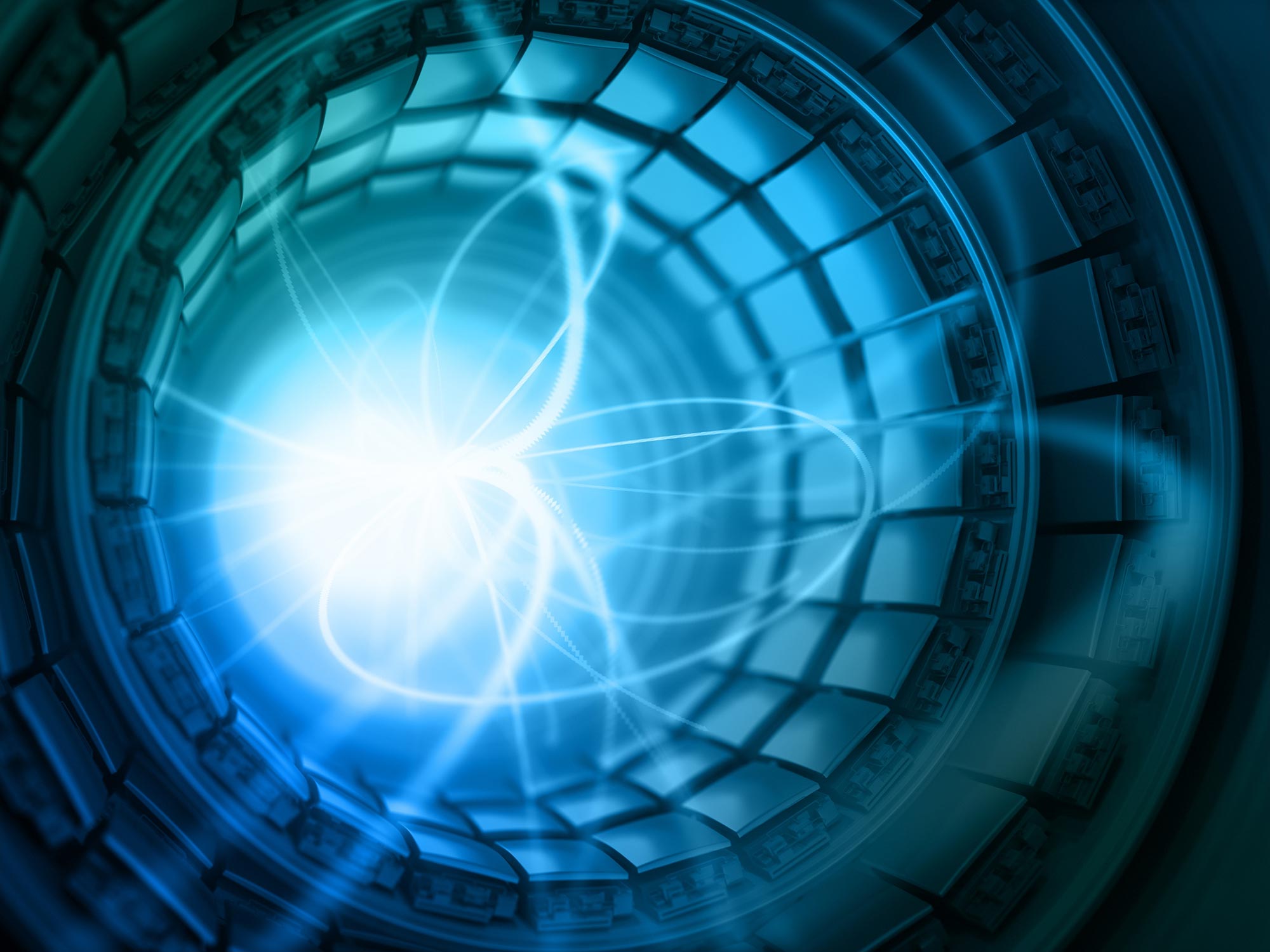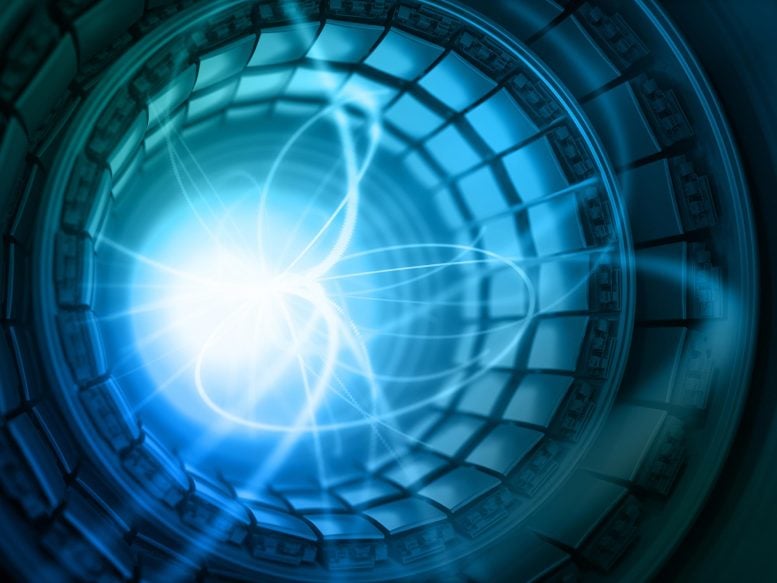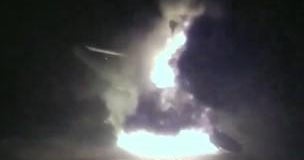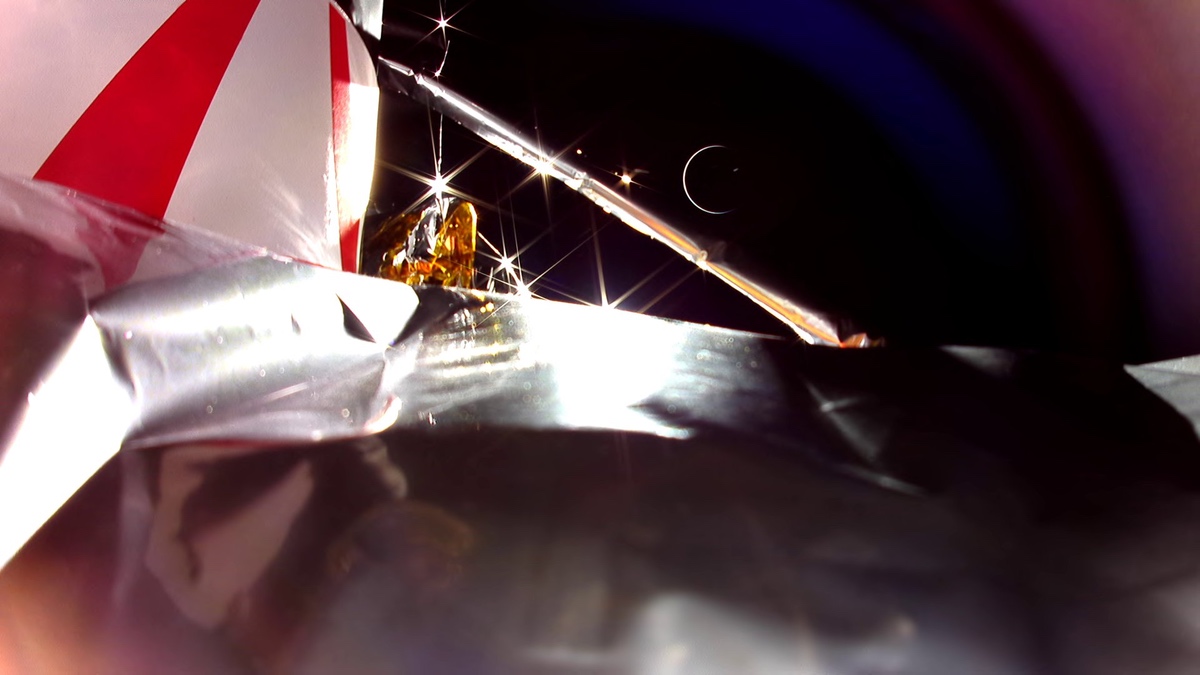Najpresnejšie meranie hmotnosti bozónu W ukazuje napätie so štandardným modelom.
Po 10 rokoch starostlivej analýzy a skúmania vedci z CDF z Fermi National Accelerator Laboratory Ministerstva energetiky USA 7. apríla 2022 oznámili, že dosiahli doteraz najpresnejšie meranie hmotnosti W bozónu, jednej z prírodných síl. nesúce častice. Pomocou údajov zozbieraných detektorom Fermilab’s Collider Detector alebo CDF vedci teraz určili hmotnosť častice s presnosťou 0,01% – dvojnásobok presnosti predchádzajúceho najlepšieho merania. Zodpovedá gorile s hmotnosťou 800 libier až 1,5 unce.
Nová presná váha uverejnená v časopise vedieť, umožňuje vedcom testovať Štandardný model časticovej fyziky, teoretický rámec, ktorý popisuje prírodu na jej najzákladnejšej úrovni. Výsledok: Nová hodnota hmotnosti ukazuje napätie s hodnotou, ktorú vedci získajú pomocou experimentálnych a teoretických vstupov v kontexte štandardného modelu.
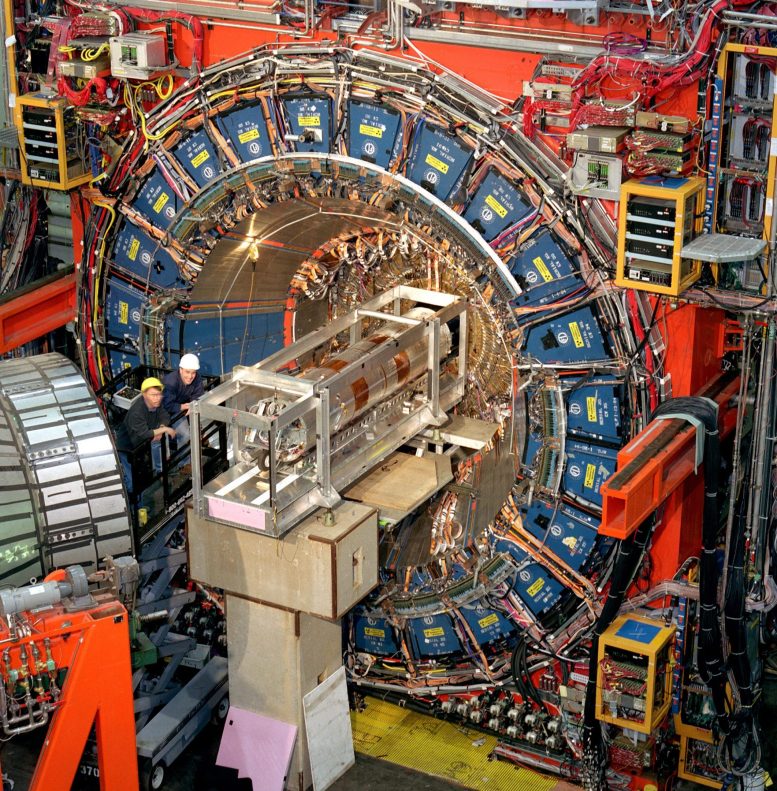
Detektor zrážača Fermilab zaznamenal zrážky vysokoenergetických častíc generované zrážačom Tevatron v rokoch 1985 až 2011. Približne 400 vedcov z 54 inštitúcií v 23 krajinách stále pracuje na množstve údajov zozbieraných experimentom. Kredit: Fermilab
„Počet vylepšení a dodatočných overení, ktoré boli vykonané v súvislosti s našimi výsledkami, je obrovský,“ povedal Ashutosh V. Kotwal z Duke University, ktorý viedol túto analýzu a je jedným zo 400 vedcov na spolupráci CDF. „Zohľadnili sme naše lepšie pochopenie nášho detektora častíc, ako aj pokroky v teoretickom a experimentálnom chápaní interakcií bozónu W s inými časticami. Keď sme konečne odhalili výsledok, zistili sme, že sa líši od predpovede štandardného modelu.“ „
Ak sa toto meranie potvrdí, naznačuje potenciálnu potrebu zlepšení na úkor štandardného modelu alebo rozšírení modelu.
Vedci teraz určili hmotnosť W bozónu s presnosťou 0,01 %. Je to dvojnásobná presnosť v porovnaní s predchádzajúcim najlepším meraním a ukazuje napätie pri štandardnom modeli.
Nová hodnota je v súlade s mnohými predchádzajúcimi meraniami hmotnosti bozónu W, existujú však aj určité rozdiely. Budúce merania budú potrebné, aby výsledok vniesli viac svetla.
„Aj keď ide o zaujímavý výsledok, meranie musí byť potvrdené ďalším experimentom, kým sa dá úplne vysvetliť,“ povedal zástupca riaditeľa Fermilabu Joe Lykken.
W bozón je posolská častica slabej jadrovej sily. Je zodpovedný za jadrové procesy, vďaka ktorým slnko svieti a molekuly sa rozpadajú. Spolupráca CDF pomocou zrážok vysokoenergetických častíc z urýchľovača Tevatron vo Fermilabe zhromaždila obrovské množstvo údajov obsahujúcich W bozóny od roku 1985 do roku 2011.
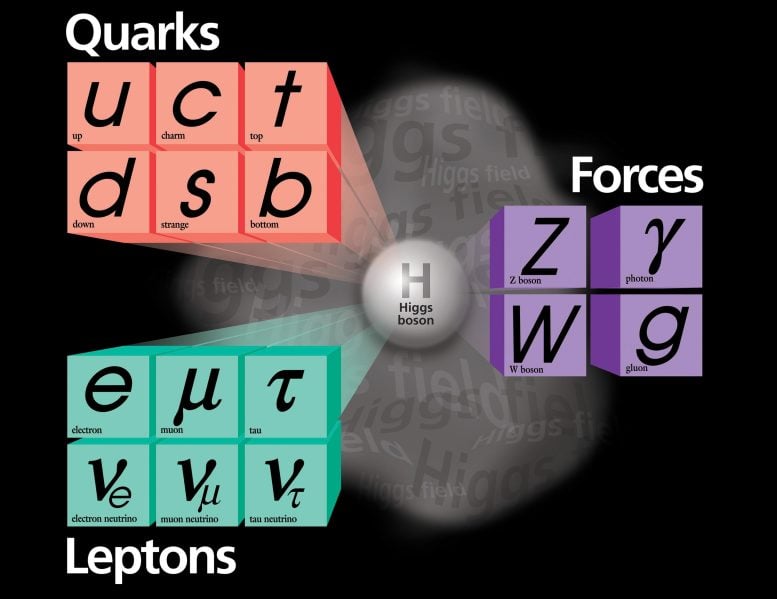
Bozón W je posolská častica slabej jadrovej sily. Je zodpovedný za jadrové procesy, vďaka ktorým slnko svieti a molekuly sa rozpadajú. Vedci z CDF študujú vlastnosti bozónu W pomocou údajov, ktoré zozbierali na zrážači Tevatron vo Fermilabe. Kredit: Fermi National Accelerator Laboratory
CDF fyzik Chris Hayes z[{“ attribute=““>University of Oxford said, “The CDF measurement was performed over the course of many years, with the measured value hidden from the analyzers until the procedures were fully scrutinized. When we uncovered the value, it was a surprise.”
The mass of a W boson is about 80 times the mass of a proton, or approximately 80,000 MeV/c2. CDF researchers have worked on achieving increasingly more precise measurements of the W boson mass for more than 20 years. The central value and uncertainty of their latest mass measurement is 80,433 +/- 9 MeV/c2. This result uses the entire dataset collected from the Tevatron collider at Fermilab. It is based on the observation of 4.2 million W boson candidates, about four times the number used in the analysis the collaboration published in 2012.
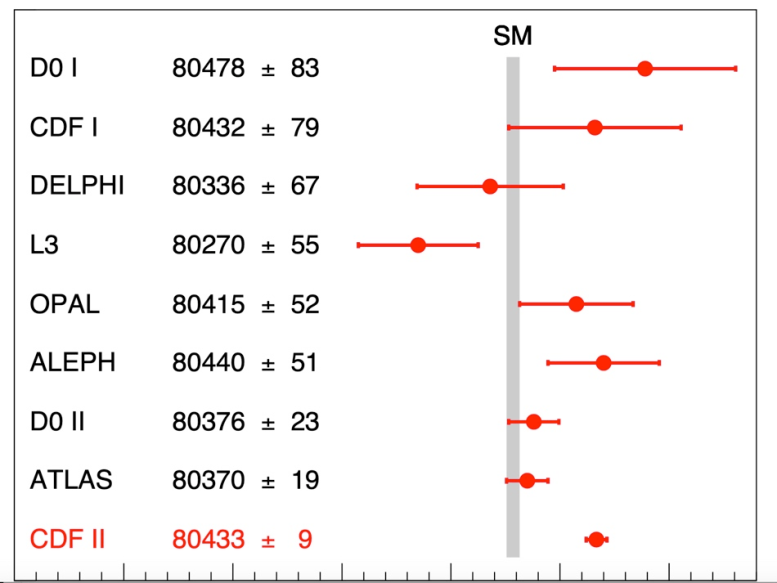
The mass of a W boson is about 80 times the mass of a proton, or approximately 80,000 MeV/c2. Scientists of the Collider Detector at Fermilab collaboration have achieved the world’s most precise measurement. The CDF value has a precision of 0.01 percent and is in agreement with many W boson mass measurements. It shows tension with the value expected based on the Standard Model of particle physics. The horizontal bars indicate the uncertainty of the measurements achieved by various experiments. The LHCb result was published after this paper was submitted and is 80354+- 32 MeV/c2. Credit: CDF collaboration
“Many collider experiments have produced measurements of the W boson mass over the last 40 years,” said CDF co-spokesperson Giorgio Chiarelli, Italian National Institute for Nuclear Physics (INFN-Pisa). “These are challenging, complicated measurements, and they have achieved ever more precision. It took us many years to go through all the details and the needed checks. It is our most robust measurement to date, and the discrepancy between the measured and expected values persists.”
The collaboration also compared their result to the best value expected for the W boson mass using the Standard Model, which is 80,357 ± 6 MeV/c2. This value is based on complex Standard Model calculations that intricately link the mass of the W boson to the measurements of the masses of two other particles: the top quark, discovered at the Tevatron collider at Fermilab in 1995, and the Higgs boson, discovered at the Large Hadron Collider at CERN in 2012.
CDF co-spokesperson David Toback, Texas A&M University, stated the result is an important contribution to testing the accuracy of the Standard Model. “It’s now up to the theoretical physics community and other experiments to follow up on this and shed light on this mystery,” he added. “If the difference between the experimental and expected value is due to some kind of new particle or subatomic interaction, which is one of the possibilities, there’s a good chance it’s something that could be discovered in future experiments.”
Reference: “High-precision measurement of the W boson mass with the CDF II detector” by CDF Collaboration, T. Aaltonen, S. Amerio, D. Amidei, A. Anastassov, A. Annovi, J. Antos, G. Apollinari, J. A. Appel, T. Arisawa, A. Artikov, J. Asaadi, W. Ashmanskas, B. Auerbach, A. Aurisano, F. Azfar, W. Badgett, T. Bae, A. Barbaro-Galtieri, V. E. Barnes, B. A. Barnett, P. Barria, P. Bartos, M. Bauce, F. Bedeschi, S. Behari, G. Bellettini, J. Bellinger, D. Benjamin, A. Beretvas, A. Bhatti, K. R. Bland, B. Blumenfeld, A. Bocci, A. Bodek, D. Bortoletto, J. Boudreau, A. Boveia, L. Brigliadori, C. Bromberg, E. Brucken, J. Budagov, H. S. Budd, K. Burkett, G. Busetto, P. Bussey, P. Butti, A. Buzatu, A. Calamba, S. Camarda, M. Campanelli, B. Carls, D. Carlsmith, R. Carosi, S. Carrillo, B. Casal, M. Casarsa, A. Castro, P. Catastini, D. Cauz, V. Cavaliere, A. Cerri, L. Cerrito, Y. C. Chen, M. Chertok, G. Chiarelli, G. Chlachidze, K. Cho, D. Chokheli, A. Clark, C. Clarke, M. E. Convery, J. Conway, M. Corbo, M. Cordelli, C. A. Cox, D. J. Cox, M. Cremonesi, D. Cruz, J. Cuevas, R. Culbertson, N. d’Ascenzo, M. Datta, P. de Barbaro, L. Demortier, M. Deninno, M. D’Errico, F. Devoto, A. Di Canto, B. Di Ruzza, J. R. Dittmann, S. Donati, M. D’Onofrio, M. Dorigo, A. Driutti, K. Ebina, R. Edgar, A. Elagin, R. Erbacher, S. Errede, B. Esham, S. Farrington, J. P. Fernández Ramos, R. Field, G. Flanagan, R. Forrest, M. Franklin, J. C. Freeman, H. Frisch, Y. Funakoshi, C. Galloni, A. F. Garfinkel, P. Garosi, H. Gerberich, E. Gerchtein, S. Giagu, V. Giakoumopoulou, K. Gibson, C. M. Ginsburg, N. Giokaris, P. Giromini, V. Glagolev, D. Glenzinski, M. Gold, D. Goldin, A. Golossanov, G. Gomez, G. Gomez-Ceballos, M. Goncharov, O. González López, I. Gorelov, A. T. Goshaw, K. Goulianos, E. Gramellini, C. Grosso-Pilcher, J. Guimaraes da Costa, S. R. Hahn, J. Y. Han, F. Happacher, K. Hara, M. Hare, R. F. Harr, T. Harrington-Taber, K. Hatakeyama, C. Hays, J. Heinrich, M. Herndon, A. Hocker, Z. Hong, W. Hopkins, S. Hou, R. E. Hughes, U. Husemann, M. Hussein, J. Huston, G. Introzzi, M. Iori, A. Ivanov, E. James, D. Jang, B. Jayatilaka, E. J. Jeon, S. Jindariani, M. Jones … P. Wagner, R. Wallny, S. M. Wang, D. Waters, W. C. Wester, D. Whiteson, A. B. Wicklund, S. Wilbur, H. H. Williams, J. S. Wilson, P. Wilson, B. L. Winer, P. Wittich, S. Wolbers, H. Wolfmeister, T. Wright, X. Wu, Z. Wu, K. Yamamoto, D. Yamato, T. Yang, U. K. Yang, Y. C. Yang, W.-M. Yao, G. P. Yeh, K. Yi, J. Yoh, K. Yorita, T. Yoshida, G. B. Yu, I. Yu, A. M. Zanetti, Y. Zeng, C. Zhou and S. Zucchelli, 7 April 2022, Science.
DOI: 10.1126/science.abk1781
The CDF collaboration comprises 400 scientists at 54 institutions in 23 countries.

„Organizátor. Spisovateľ. Zlý kávičkár. Evanjelista všeobecného jedla. Celoživotný fanúšik piva. Podnikateľ.“

